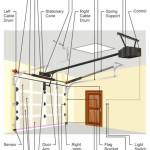Wire Size for Garage Door Openers: A Comprehensive Guide
Selecting the correct wire size for a garage door opener installation is a critical aspect of ensuring safe and reliable operation. Improper wire sizing can lead to a multitude of problems, ranging from voltage drops and inefficient motor performance to overheating and potential fire hazards. This article provides a comprehensive overview of the factors involved in determining the appropriate wire gauge for a garage door opener, emphasizing the importance of adhering to electrical codes and manufacturer specifications. Understanding the principles behind wire sizing and the relevant electrical parameters is essential for both professional electricians and homeowners undertaking DIY installations or repairs.
The primary function of electrical wiring is to efficiently deliver power from the electrical panel to the garage door opener unit. The wire acts as a conductor, allowing electrical current to flow and power the motor that raises and lowers the garage door. The wire's ability to carry current without excessive resistance is directly related to its gauge, which is a standardized measurement of its diameter. A lower gauge number indicates a thicker wire, capable of carrying more current over a longer distance with less voltage drop. Conversely, a higher gauge number indicates a thinner wire with a lower current carrying capacity.
Choosing the wrong wire size can have significant consequences. Undersized wires present a higher resistance to the flow of electricity, leading to a voltage drop. This voltage drop reduces the power available to the garage door opener motor, potentially causing it to operate sluggishly or fail to function altogether. Furthermore, the increased resistance generates heat within the wire. Excessive heat can damage the insulation, leading to short circuits, electrical fires, and potential damage to the garage door opener unit itself. Therefore, careful consideration must be given to wire size selection to ensure both safety and optimal performance.
Key Factors Influencing Wire Size Selection
Determining the appropriate wire size for a garage door opener involves considering several key factors that directly impact the electrical demands of the system and the capabilities of the wiring. These factors include the amperage rating of the garage door opener motor, the voltage of the electrical circuit, the distance the wire needs to travel from the electrical panel to the opener, and the applicable electrical codes and standards.
Amperage Rating: The amperage rating of the garage door opener motor is the most crucial factor in determining the appropriate wire size. The amperage rating, often abbreviated as amps, represents the amount of electrical current the motor draws during operation. This value is typically found on the nameplate of the garage door opener unit or in the manufacturer's specifications. It is imperative to use a wire size that is rated to safely handle at least the rated amperage of the motor. Exceeding the wire's current carrying capacity can lead to overheating and potential fire hazards.
Voltage: The voltage of the electrical circuit supplying power to the garage door opener is another important consideration. In most residential applications, garage door openers operate on a 120-volt circuit. However, it is essential to verify the voltage of the circuit before selecting the wire size. Voltage drop is more pronounced at lower voltages, meaning that longer wire runs will require thicker gauge wires to maintain adequate voltage at the garage door opener.
Distance (Wire Run Length): The distance the wire needs to travel from the electrical panel to the garage door opener, known as the wire run length, plays a significant role in determining the required wire size. As electricity travels through a wire, it encounters resistance, which causes a drop in voltage. The longer the wire run, the greater the voltage drop. To compensate for voltage drop over longer distances, a thicker gauge wire is needed. Electrical codes typically provide tables and formulas to calculate the voltage drop based on wire length, amperage, and wire gauge. Using these resources is crucial for ensuring that the voltage at the garage door opener remains within acceptable limits.
Electrical Codes and Standards: All electrical installations, including those for garage door openers, must comply with applicable electrical codes and standards. In the United States, the National Electrical Code (NEC) is the most widely adopted standard. The NEC provides detailed requirements for wire sizing, installation methods, and safety measures. Local building codes may also have specific requirements that must be followed. Consulting with a qualified electrician or building inspector is recommended to ensure compliance with all applicable codes and standards.
Understanding Wire Gauge and Ampacity
Wire gauge, as defined by the American Wire Gauge (AWG) system, is a numerical representation of the wire's diameter. The lower the AWG number, the thicker the wire and the higher its current carrying capacity. Conversely, the higher the AWG number, the thinner the wire and the lower its current carrying capacity. Selecting the appropriate AWG size depends on the amperage of the garage door opener, the voltage of the circuit, and the length of the wire run.
Ampacity refers to the maximum amount of electrical current a wire can safely carry without exceeding its temperature rating. Ampacity is determined by several factors, including the wire gauge, the insulation type, and the ambient temperature. The NEC provides tables that list the ampacity of different wire gauges and insulation types. When selecting a wire size, it is crucial to ensure that its ampacity is sufficient to handle the amperage of the garage door opener, with a safety margin to account for potential surges or overloads.
For example, a common garage door opener might draw 6 amps. According to NEC tables, a 14-gauge copper wire with Type THHN insulation has an ampacity of 15 amps, which would be sufficient for this application, provided the wire run is not excessively long. However, for longer wire runs, a larger gauge wire (e.g., 12-gauge) might be necessary to minimize voltage drop. It's crucial to always consult the NEC tables and consider the specific conditions of the installation to determine the appropriate wire size.
The type of wire insulation also affects ampacity. Common insulation types include THHN, THWN, and UF. Each type has a different temperature rating and moisture resistance. The NEC tables specify the ampacity for each insulation type under various conditions. Using the correct type of wire for the intended environment is essential for ensuring safety and longevity.
Practical Examples and Wire Size Chart
To illustrate the wire size selection process, consider a few practical examples. Suppose a garage door opener draws 5 amps and operates on a 120-volt circuit. The distance from the electrical panel to the opener is 50 feet. In this case, a 14-gauge copper wire with THHN insulation would likely be sufficient, as it has an ampacity of 15 amps. However, to minimize voltage drop, a 12-gauge wire might be a better choice, especially if the garage door opener motor is particularly sensitive to voltage fluctuations.
Now, consider a scenario where the garage door opener draws 8 amps and the distance from the electrical panel to the opener is 100 feet. In this case, a 14-gauge wire might not be sufficient due to the longer wire run and the higher amperage. A 12-gauge copper wire with THHN insulation, which has an ampacity of 20 amps, would be a more appropriate choice. Using a voltage drop calculator or consulting the NEC tables can help determine the exact wire size needed to maintain acceptable voltage levels at the garage door opener.
The following table provides a general guideline for wire size selection based on amperage and distance for 120-volt circuits using copper wire with THHN insulation. This table is for illustrative purposes only and should not be used as a substitute for consulting the NEC or a qualified electrician.
Wire Size Chart (Approximate):
| Amperage (Amps) | Distance (Feet) | Recommended Wire Gauge (AWG) | |---|---|---| | 5 | 50 | 14 | | 5 | 100 | 12 | | 8 | 50 | 14 | | 8 | 100 | 12 | | 10 | 50 | 12 | | 10 | 100 | 10 | | 12 | 50 | 12 | | 12 | 100 | 10 | | 15 | 50 | 10 | | 15 | 100 | 8 |
It is imperative to remember that this table is a simplification. Factors such as ambient temperature, wire bundling, and voltage drop considerations can significantly impact the required wire size. Always consult the NEC and a qualified electrician to ensure the correct wire size is selected for the specific application.
In addition to selecting the correct wire size, it is also important to use appropriate wiring methods. This includes using the correct type of conduit or cable, properly securing the wiring, and making secure connections at the electrical panel and the garage door opener. Loose or corroded connections can create resistance, leading to voltage drop and potential overheating. Using wire connectors that are rated for the specific wire size and type is also crucial for ensuring reliable connections.
Furthermore, it is essential to install a properly sized circuit breaker to protect the wiring and the garage door opener. The circuit breaker should be rated to protect the smallest gauge wire in the circuit. For example, if a 14-gauge wire is used, the circuit breaker should not exceed 15 amps. Using an oversized circuit breaker can allow excessive current to flow through the wiring, potentially leading to overheating and fire hazards. Always consult the NEC and a qualified electrician to determine the appropriate circuit breaker size.
The information presented in this guide is intended for general informational purposes only and should not be considered a substitute for professional electrical advice. Always consult with a qualified electrician to ensure that any electrical work is performed safely and in compliance with all applicable codes and standards. Improper electrical wiring can be dangerous and may result in serious injury or property damage.

Genie Garage Door Opener Wire The Company

Garage Door Operator Prewire And Framing Guide

Garage Door Opener Wire
Garage Door Wiring Diy Home Improvement Forum

Bell Wire 22 2 Garage Door Opener

Garage Door Opener Wire

Liftmaster Garage Door Sensor Wire Black White 500 21 2lm 22 Gauge 2 Strand

Bell Wire 22 2 Garage Door Opener

Garagemax Bluemate Labs Inc

Garage Door Cable And Fittings








